|
| |
Back to light
transports
 |
The Fairchild 71 is an antique transport
machine which first flew in 1929. Originally designed for aerial
surveys, but widely adopted by operators such as Canadian bush
fliers, it seats seven. Powered by a 420hp Pratt & Whitney Wasp
engine, it cruises at 110mph over a range of 650 miles. It is 35
feet 10 inches long; its 50 foot 2 inch wings can be folded for
easier storage.
This is one of a few which still exist, and was pictured at
Snohomish, September 1981 |
 |
Grumman at one time specialised in flying
boats. The Grumman HU-16 Albatross was originally built for a US Navy
requirement for a medium-sized floatplane carrying 10 to 12 people.
It was a rugged, capable aircraft and was very successful in its
role. Demand for flying boats is limited and their cost high, but
despite that 464 were built. They had two radial piston engines of
1,425 horsepower each, and had a fuel endurance of about nine hours.
This very smart example was at Paris-Le Bourget
in June 1981. |
 |
The Grumman Goose was originally a commercial
flying boat design, first flown in June 1937. With the outbreak of
the second world war, most of the 250 Geese made were completed as
US Navy aircraft under the designation JRF. The engines are Pratt & Whitney Wasp radials.It
can carry up to 14 passengers at up to 220mph for up to 1,200 miles.
Many remain active today, including this one
(N327) seen on a very foggy morning at Arlington in September 1981.
|
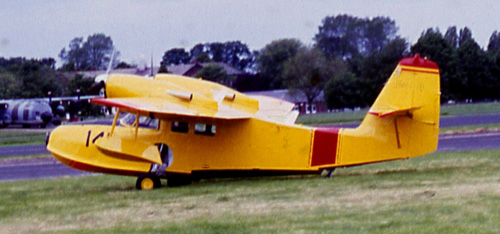 |
The Grumman G-44 Widgeon is a six seat
amphibian powered by two 200hp Ranger inline engines. The original
concept was for a machine with the same general mission profile as
the Goose, but much smaller. It first flew in July 1940. It cruises
at 130mph and has a range of 1,000 miles. It is 31 feet 1 inch long,
with a wing span of 40 feet. 266 were built, mostly after the war.
This one was at
Biggin Hill, June 1987 |
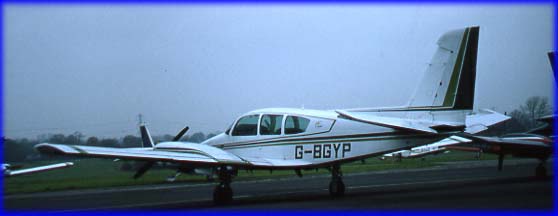 |
The Grumman Cougar was Grumman's attempt to
enter the light twin market following their takeover of American
Aviation. It was not a success, offering no real advantages over the
many established designs in its class, especially the Piper Seneca.
Only 115 were built This one was at
Elstree on a very gloomy day in October 1982. |
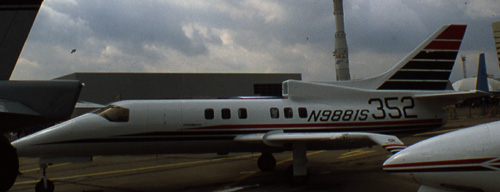 |
The Gulfstream Peregrine was unusual for an
executive jet in being single engined. It is powered by by a 3,500lb
Garrett TFE731 engine, which gave it a cruising speed of 435mph and
range of 1,700 miles. It first flew in January 1983. It was 41 feet
2 inches long, with a wing span of 45 feet 2 inches. It is a six
seater, with gross weight of 9,400lb. However, only one was built;
the project was cancelled due to lack of orders. A military trainer
version, the NGT, was similarly unsuccessful.
It was demonstrated at Paris in May 1983. |
 |
The Grumman Gulfstream was one of the first
corporate turboprop aircraft in the world. It first flew in August
1958, predating the classic Beech Kingair by five years. It was also
much bigger, being able to seat up to 14 people. Powered by two
Rolls-Royce Dart turboprops, it was very capable: it could fly at
360mph for up to 2,700 miles. After 200 had been built, it was
superseded by corporate jet designs. Some were used by the US air
force as executive transports (C-4) and navigation trainers (T-41
Academe). Some were converted to G1C commuter airliners
after the corporate division of Grumman had been spun off as a
separate company and renamed Gulfstream.
This Gulfstream was at Geneva in September 1982. |
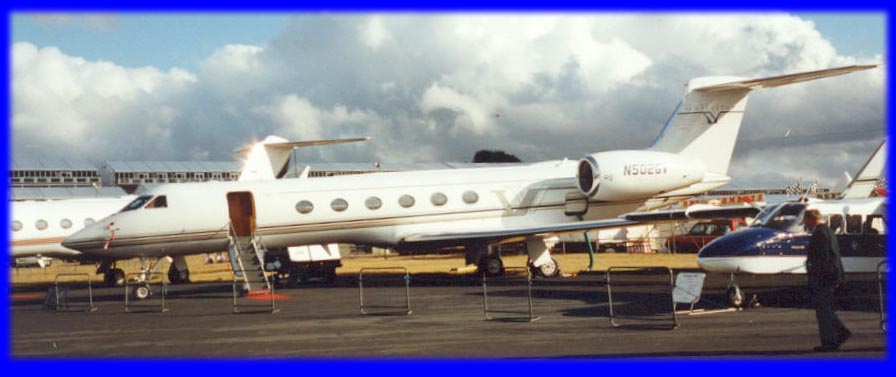 |
Grumman developed the Gulfstream 2 in 1966 as
the `ultimate executive jet': with range of 3,500 miles at 560mph
and seating 19 people in real luxury, it is a very impressive - and
expensive - aircraft. The division was spun off as a separate
company and renamed Gulfstream Aircraft, and has continued to
develop the design progressively over the years. Gulfstreams have
been used by the USAF as executive transports, including the
Gulfstream 2 (C-11), 3 (C-20) and 5 (C-37).
Illustrated is a Gulfstream 5, seen at
Farnborough in 1998. |
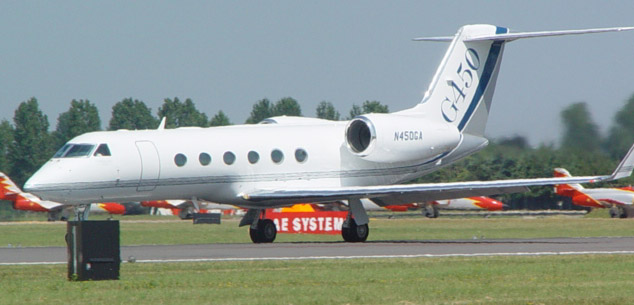 |
The Gulfstream 450 is essentially an updated
version of the Gulfstream IV luxury executive jet. It first flew in
April 2003. It is powered by two 13,850lb Rolls Royce Tay engines,
which give it a cruising speed of Mach 0.8 and range of 5,000 miles.
It can seat up to 19 passengers. It is one of the largest executive
jets, with gross weight of 73,900lb, 89 feet 4 inches long, with a
wing span of 77 feet 10 inches.
This company demonstrator was at
Fairford in July 2005 |
|
|
Bill Lear designed the Lear Jet as the sports
car of the sky. It is a sleek and fast executive jet, with a speed
over 500 mph at the expense of a somewhat cramped cabin. It is
synonymous with executive luxury (for example, it is cited as such
in the Carly Simon song `You're So Vain'). Although originally a
light and small aircraft, the basic Lear Jet design has been
upgraded through several versions. The US Air Force has used two
variants as the C-21 and C-35. Top
picture - Lear Jet 24 (modified as a target tug) at Farnborough,
September 1976. Middle
picture - Lear Jet 35 operated by the Finnish Air Force, Fairford,
July 2005 Lower picture - Lear Jet 45 at
Biggin Hill in 2007. |
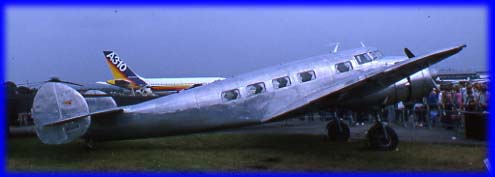 |
The Lockheed 10 Electra was Lockheed's first
twin engined transport. It first flew in 1934 and was built in
considerable quantity. It could take up to 10 passengers for 880
miles at 180 mph, powered by two Pratt & Whitney Wasp radial
engines. The US Air Force used several under a variety of
designations, most frequent being C-35. This Electra visited
Farnborough in September 1982. |
 |
The Lockheed Lodestar was a much bigger and
more robust aircraft than the Electra. Almost a fully fledged
airliner, it could take 14 passengers at 280 mph for 3,800 miles,
powered by two Wright Cyclone radial engines. At the outbreak of
war, many were impressed into US Air Force service under a range of
designations, chiefly C-60. Many survive as luxury executive
transports for people with a sense of history and nostalgia.
This Lodestar was at Paine in September 1981. |
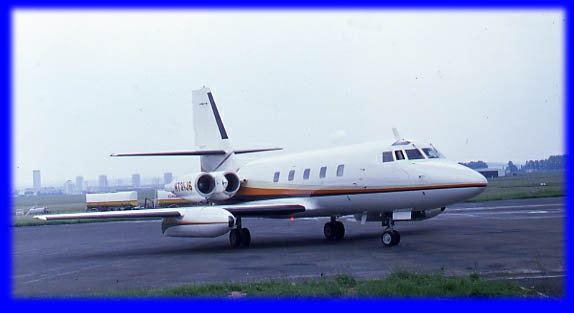 |
The Lockheed JetStar first flew in September
1957, making it one of the earliest of the new breed of executive
jets. It is unique among the purpose built business jets in having
four engines, which is good for speed and safety but not so good for
range (its range is only 2,200 miles, even with those huge fuel
tanks in the wings). It is however a very luxurious way of getting
ten people about. Some are used by the USAF for senior generals,
designated C-140. This JetStar 731, with
uprated engines, was at Beauvais in France in June 1979. |





|